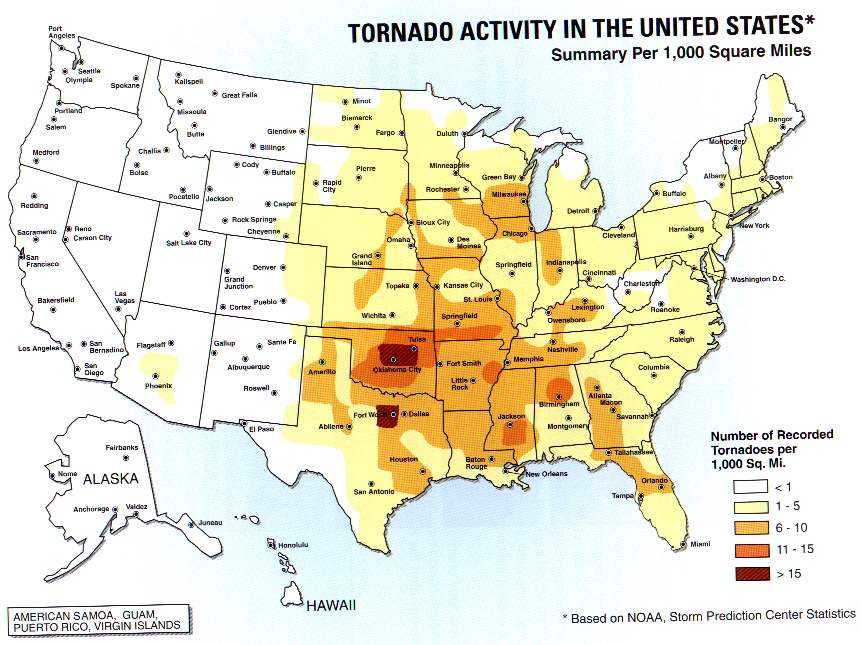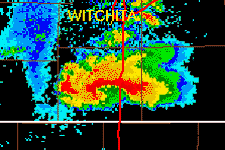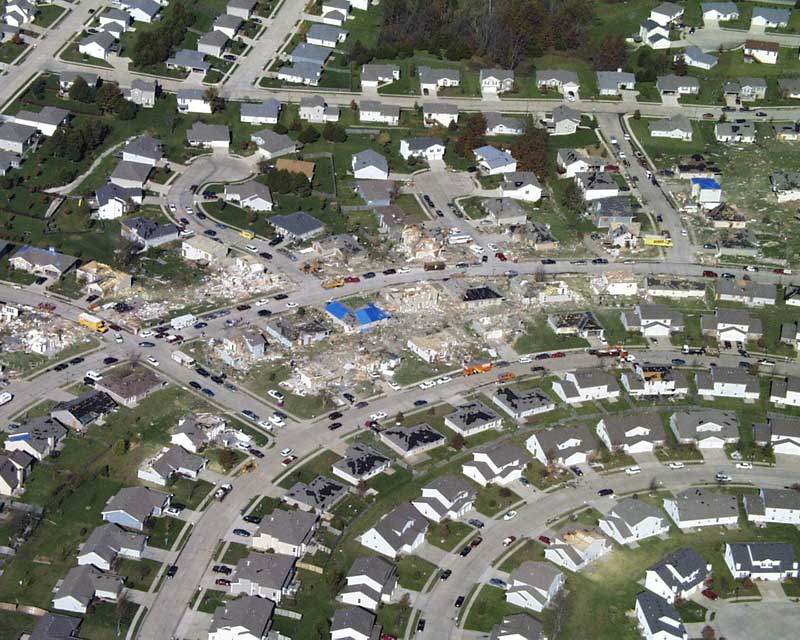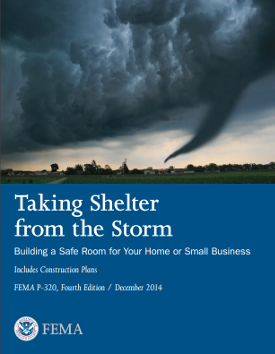Tornadoes
Local Weather via the National Weather Service
Although the full details of how tornadoes form are not well known, they generally form in a huge, rotating thunderstorm called a super cell. Super cell thunderstorms form where cold dry polar air meets warm moist tropical air. When this happens the warm updraft punches through the overlying, stable layer and continues upward into a zone of cool, dry air. The resulting instabilities produce powerful vortex motions, the lifeblood of tornadoes. Tornadoes generally form in a part of the Super cell called a mesocyclone. A mesocyclone draws energy into the storm, helping the storm to last for hours.

The funnel clouds that are the most easily recognizable parts of a tornado usually seem to descend from the cloud base. This does not mean that the vortex is descending from the cloud base, rather the vortex already extends from inside the clouds all the way down to the ground. The "descent" of the funnel cloud is usually caused when the air pressure inside the vortex drops due to increased wind speed. This drop in air pressure causes the ambient moisture in the air to condense — which is what you see.
Moisture in the atmosphere condenses at a certain temperature and pressure combination, called the dew point. In general, in the vortex of a tornado, the pressure is fairly constant along the entire height, but the temperature is usually higher near the ground than neat the top of the vortex. As the pressure inside the vortex drops, the moisture condenses, beginning at the top of the vortex, where the temperature is lowest and continuing downwards, thus the impression that the funnel cloud is "descending." Sometimes, however, the temperature is warmer near the top of the vortex than near the ground, which causes the funnel cloud to "ascend" to the cloud base.
A common myth about tornadoes is that the tornado doesn't actually exist until the funnel cloud "descends" and touches down. This, however, is not exactly true. The vortex can exist without the funnel cloud — and indeed can cause considerable damage without producing a funnel cloud, however, this situation is rare. Don't be fooled by the absence of a funnel cloud.
Typically, the only indication of a pending tornado is the presence of a hook echo seen on conventional radar. Hook echoes generally signify the presence of rotation in a storm, however, not all storms that return hook echoes produce tornadoes.

In the U.S., tornadoes are classified according to a system known as the Fujita or Fujita-Pearson scale, named after Prof. Theodore Fujita, retired professor at the University of Chicago, and Dr. Alan Pearson, former director of the National Severe Storm Forecast Center (NSSFC), who devised the system in 1971. This scale relates the wind speed of a tornado to the amount of damage done.
Tornado Danger Signs
Learn these tornado danger signs:
- An approaching cloud of debris can mark the location of a tornado even if a funnel is not visible.
- Before a tornado hits, the wind may die down and the air may become very still.
- Tornadoes generally occur near the trailing edge of a thunderstorm. It is not uncommon to see clear, sunlit skies behind a tornado.
Prepare a Home Tornado Plan
Pick a place where family members could gather if a tornado is headed your way. It could be your basement or, if there is no basement, a center hallway, bathroom, or closet on the lowest floor. Keep this place uncluttered. If you are in a high-rise building, you may not have enough time to go to the lowest floor. Pick a place in a hallway in the center of the building. Assemble a Tornado Safety Kit containing:
- First aid kit and essential medications
- Battery-powered radio, flashlight, and extra batteries
- Canned food and can opener
- Bottled water
- Sturdy shoes and work gloves
Also include in the kit written instructions on how to turn off your home's utilities. Conduct periodic tornado drills, so everyone remembers what to do when a tornado is approaching.
Mobile Homes
Mobile homes are particularly vulnerable. A mobile home can overturn very easily even if precautions have been taken to tie down the unit. When a tornado warning is issued, take shelter in a building with a strong foundation. If shelter is not available, lie in ditch or low-lying area a safe distance away from the unit.
Stay tuned for storm warnings. Listen to your local radio and TV stations for updated storm information.
Media in the Columbia Area: National Oceanic and Atmospheric Administration (NOAA) Weather Radio 162.400Mhz; KFRU Radio 1400 AM
Know What a Tornado WATCH and WARNING Means
When a Tornado WATCH is Issued
Listen to local radio and TV stations for further updates. Be alert to changing weather conditions. Blowing debris or the sound of an approaching tornado may alert you. Many people say it sounds like a freight train.
When a Tornado WARNING is Issued
If you are inside, go to the safe place you picked to protect yourself from glass and other flying objects. The tornado may be approaching your area. If you are outside, hurry to the basement of a nearby sturdy building or lie flat in a ditch or low-lying area. If you are in a car or mobile home, get out immediately and head for safety (as above).

Click the image above to view images of common storm clouds and formations
During a Tornado
At Home
- Go at once to the basement, storm cellar, or the lowest level of the building.
- If there is no basement, go to an inner hallway or a smaller inner room without windows, such as a bathroom or closet.
- Get away from the windows.
- Go to the center of the room. Stay away from corners because they tend to attract debris.
- Get under a piece of sturdy furniture such as a workbench or heavy table or desk and hold on to it.
- Use arms to protect head and neck.
- If in a mobile home, get out and find shelter elsewhere.
At Work or School
- Go to the basement or to an inside hallway at the lowest level.
- Avoid places with wide-span roofs such as auditoriums, cafeterias, large hallways, or shopping malls.
- Get under a piece of sturdy furniture such as a workbench or heavy table or desk and hold on to it.
- Use arms to protect head and neck.
Outdoors
- If possible, get inside a building
- If shelter is not available or there is no time to get indoors, lie in a ditch or low-lying area or crouch near a strong building. Be aware of the potential for flooding.
- Use arms to protect head and neck.
In a Car
- Never try to out drive a tornado in a car or truck. Tornadoes can change direction quickly and can lift up a car or truck and toss it through the air.
- Get out of the car immediately and take shelter in a nearby building.
- If there is no time to get indoors, get out of the car and lie in a ditch or low-lying area away from the vehicle. Be aware of the potential for flooding.
After the Tornado Passes
Help injured or trapped persons.
Give first aid when appropriate. Don't try to move the seriously injured unless they are in immediate danger of further injury. Call for help.
- Turn on radio or television to get the latest emergency information.
- Stay out of damaged buildings. Return home only when authorities say it is safe.
- Use the telephone only for emergency calls.
- Clean up spilled medicines, bleaches, or gasoline or other flammable liquids immediately. Leave the buildings if you smell gas or chemical fumes.
- Take pictures of the damage - both to the house and its contents - for insurance purposes.
Remember to help your neighbors who may require special assistance - infants, the elderly, and people with disabilities.

Click the image above to view images of damage done by Southridge Tornado
Inspecting Utilities in a Damaged Home
Check for gas leaks. If you smell gas or hear a blowing or hissing noise, open a window and quickly leave the building. Turn off the gas at the outside main valve if you can and call the gas company from a neighbor's home. If you turn off the gas for any reason, it must be turned back on by a professional.
Look for electrical system damage. If you see sparks or broken or frayed wires, or if you smell hot insulation, turn off the electricity at the main fuse box or circuit breaker. If you have to step in water to get to the fuse box or circuit breaker, call an electrician first for advice.
Check for sewage and water lines damage. If you suspect sewage lines are damaged, avoid using toilets and call a plumber. If water pipes are damaged, contact the water company and avoid using water from the tap. You can obtain safe water by melting ice cubes.

